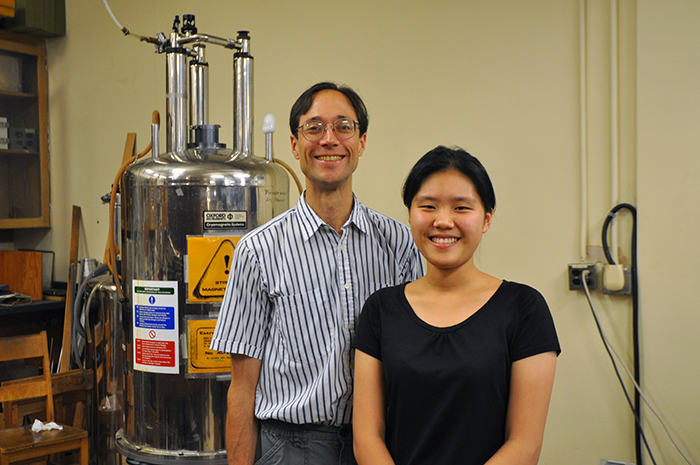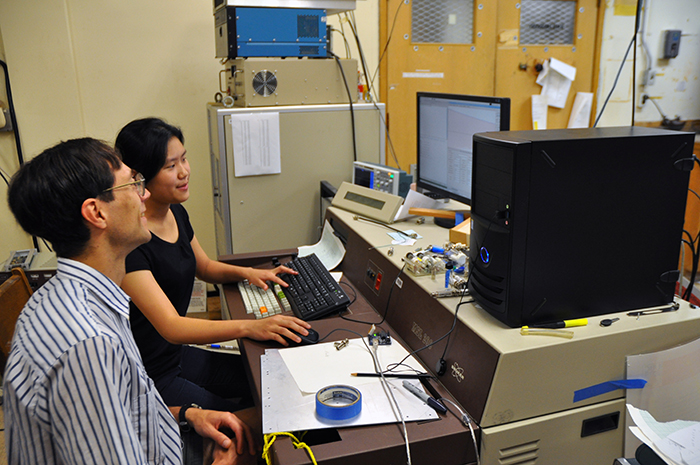2016 FYSRE recipient interview: Esther Lin
We caught up with Esther Lin, recipient of the 2016 Erich Vogt First Year Science Research Experience, to learn about her 2016 summer project. Esther is now a student in our Engineering Physics program.

Can you give us some background on what you did?
Multiple Sclerosis is a demyelinating disease that poses significant damage to our nervous system. Dr. Alex MacKay and Dr. Carl Michal’s group has been investigating techniques that can assist in the identification and understanding of myelin and myelin-water. Through FYSRE, I was given the opportunity to join the team, where I worked on the project “Measuring myelin water fraction and inhomogeneous magnetization transfer in white matter tissue” using Nuclear Magnetic Resonance (NMR) spectroscopy.
The first few weeks were both challenging and stimulating. I went through a bootcamp of publications and papers on myelin water fraction and inhomogeneous magnetization transfer, while trying to understand what NMR spectroscopy is. NMR spectroscopy has many amazing applications, due to the fact that one is observing how atomic nuclei absorb and emit electromagnetic radiation whilst in a strong magnetic field. Not only did I learn about my lab’s research, I was also introduced to many areas of physics, such as medical imaging and chemical physics. My learning process was catalyzed by terrific lab members who were able to explain concepts clearly and efficiently.
In addition, I developed a deep appreciation for mathematics through the processing of NMR signals. NMR signals were presented in both the time domain and frequency domain, as different observations could be made from both. Converting from time to frequency pushed me to study the Fourier Transform. In the process, I became acquainted with functions I didn’t even know existed. I learned something new every day. I saw that spins differed for protons based on their locations and neighboring molecules. I witnessed water from various parts of the brain behave differently in terms of different signal decay times. I had the opportunity to dissect a pig brain for white matter. I wrote pulse sequences to manipulate proton spins. Through these tasks, I was exposed to research and knowledge that was beyond anything I could have imagined.
Every member of my lab was passionate about his or her work. On days when experiments would not work, or times when confusing signals were appearing, they were able to convert their frustration into motivation. Their passion for their research was palpable whenever they gave an explanation, or related their research to industrial or clinical applications. Through them, I have gained a desire to keep learning and to never stop being curious. Their enthusiasm has fueled my desire to explore as much as possible in my undergraduate studies and to pursue my curiosities. FYSRE gave me the opportunity to experience research, and I am forever grateful for the opportunity I have been given.
Has this experience changed your mind about working in Physics?
This experience has consolidated my desire to work in Physics. As an Engineering Physics student, I sit at the cross-section of science and engineering. FYSRE has given me the opportunity to witness the importance of these areas in research. It has opened many doors for me, in terms of career interests and academic pursuits.
What were the new experiences you had that were made possible because of FYSRE support?

Dr. Michal’s lab was a paradise for me! First and foremost, I had full access to the NMR spectrometer! The opportunity liberated me to see, produce, and comprehend the NMR signals mentioned in papers. For example, the idea of spin in quantum mechanics was very hard for me to visualize. Nevertheless, after trying out a few spin echo pulse sequences on the spectrometer and seeing an NMR signal, I was able to wrap my head around the topic. I was able to satisfy many curiosities, both project related and personal, because of the freedom I had with the spectrometer.
The lab meetings I participated in were also eye-opening. Weekly presentations in the MRI Research Centre provided me with fundamental knowledge in MRI, as well as an idea of the wide breadth of ongoing research in the field. Weekly lab meetings also increased my interest in NMR and its various applications. I have received valuable introductions into many topics in physics and engineering through this experience. This experience has helped me find passion in many of my studies, especially in signal processing. In fact, signal processing will play a dominant role in my co-op job next term!
Any memorable moments?
Amongst the numerous significant moments, one that stands out is the day when we were preparing pig brains for ex vivo experiments. We wanted to measure the myelin water fraction and inhomogeneous magnetization transfer in white matter tissue. We had been testing with phantoms such as hair conditioner.
The first silly thought that struck me was that a pig brain was smaller than I had imagined! After getting over the initial queeziness, I was struck again by feelings of awe. Physics is not just equations on paper; it has applications everywhere. There I was, looking for white matter in pig brain, so I can do experiments to investigate myelin using the spin 1 system. Physics can be applied in such a wide variety of topics!
And anything else you would like you add about working there.
I am very grateful for this experience. Everyone was a joy to work with, and I learned so much over the summer. Dr. MacKay and Dr. Michal are both extremely passionate about their research, and their dedication and motivation spurred me to inquire and explore. Together with every member of the lab, they gave me the best summer of my life!